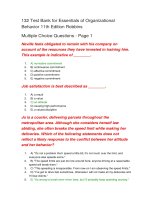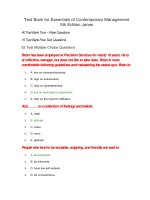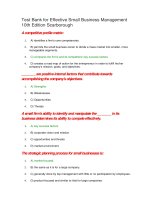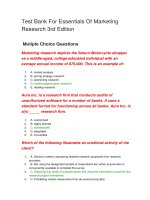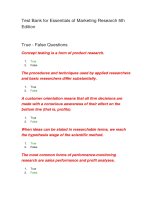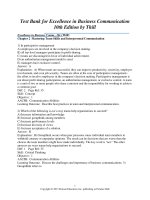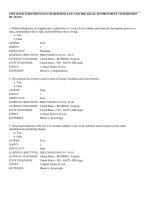Test bank for essentials of business communication 10th edition by guffey
Bạn đang xem bản rút gọn của tài liệu. Xem và tải ngay bản đầy đủ của tài liệu tại đây (605.43 KB, 49 trang )
Test Bank for Essentials of Business Communication
10th Edition by Guffey
1. Communication is defined as "the transmission of information and meaning from one
individual or group to another." The crucial element of this definition is
a. transmission.
b. information.
c. meaning.
d. individual.
ANSWER:
RATIONALE:
c
Communication is successful only if meaning is exchanged,
making "meaning" the crucial element. You can send information;
but if it means nothing to the receiver, true communication has not
occurred.
POINTS:
1
DIFFICULTY:
Easy
REFERENCES:
p. 36
LEARNING OBJECTIVES: ESBC.GULO.16.02.01 - 02.01
NATIONAL STANDARDS: United States - BUSPROG.ESBC.GULO.16.01.02 DISC.ESBC.GULO.16.01.02
TOPICS:
Understanding the Communication Process
KEYWORDS:
Bloom's: Knowledge
2. The communication process begins when the sender
a. determines the appropriate communication channel.
b. has an idea.
c. encodes an idea into a message.
d. plans for feedback.
ANSWER:
b
RATIONALE:
The communication process begins when the sender has an idea.
POINTS:
1
DIFFICULTY:
Easy
REFERENCES:
p. 36
LEARNING OBJECTIVES: ESBC.GULO.16.02.01 - 02.01
NATIONAL STANDARDS: United States - BUSPROG.ESBC.GULO.16.06.04 DISC.ESBC.GULO.16.06.04
TOPICS:
Understanding the Communication Process
KEYWORDS:
Bloom's: Knowledge
3. Converting ideas into words or gestures to convey meaning is called
a. feedback.
b. decoding.
c. encoding.
d. nonverbal communication.
ANSWER:
c
RATIONALE:
The second step of the communication process involves encoding,
converting ideas into meaningful words or gestures.
POINTS:
1
DIFFICULTY:
Easy
REFERENCES:
p. 37
LEARNING OBJECTIVES: ESBC.GULO.16.02.01 - 02.01
NATIONAL STANDARDS: United States - BUSPROG.ESBC.GULO.16.06.04 DISC.ESBC.GULO.16.06.04
TOPICS:
Understanding the Communication Process
KEYWORDS:
Bloom's: Knowledge
4. A communication channel
a. is anything that interrupts the transmission of a message.
b. should be selected before idea formation.
c. includes only digital means for transmitting messages.
d. is the medium over which the message travels.
ANSWER:
d
RATIONALE:
The medium over which the message travels is the channel.
POINTS:
1
DIFFICULTY:
Easy
REFERENCES:
p. 37
LEARNING OBJECTIVES: ESBC.GULO.16.02.01 - 02.01
NATIONAL STANDARDS: United States - BUSPROG.ESBC.GULO.16.06.04 DISC.ESBC.GULO.16.06.04
TOPICS:
Understanding the Communication Process
KEYWORDS:
Bloom's: Knowledge
5. Which of the following is not an element of the communication process?
a. Forming an idea
b. Selecting a communication channel
c. Displaying empathy
d. Providing feedback
ANSWER:
c
RATIONALE:
The communication process involves these five steps: forming an
idea, encoding the idea, selecting a channel and transmitting the
message, decoding the message, and providing feedback.
POINTS:
1
DIFFICULTY:
Easy
REFERENCES:
p. 37
LEARNING OBJECTIVES: ESBC.GULO.16.02.01 - 02.01
NATIONAL STANDARDS: United States - BUSPROG.ESBC.GULO.16.06.04 DISC.ESBC.GULO.16.06.04
TOPICS:
Understanding the Communication Process
KEYWORDS:
Bloom's: Knowledge
6. The process of translating a message from its symbol form into meaning is called
a. feedback.
b. decoding.
c. encoding.
d. noise.
ANSWER:
b
RATIONALE:
The fourth step of the communication process involves decoding or
translating the message from its symbol form into meaning.
POINTS:
1
DIFFICULTY:
Easy
REFERENCES:
p. 38
LEARNING OBJECTIVES: ESBC.GULO.16.02.01 - 02.01
NATIONAL STANDARDS: United States - BUSPROG.ESBC.GULO.16.06.04 DISC.ESBC.GULO.16.06.04
TOPICS:
Understanding the Communication Process
KEYWORDS:
Bloom's: Knowledge
7. Communication noise
a. occurs only with the sender in the communication process.
b. includes only environmentally produced sounds that prevent the message from being
transmitted.
c. is anything that interrupts the transmission of a message.
d. describes the medium over which the message travels.
ANSWER:
c
RATIONALE:
Anything that interrupts the transmission of a message is called
noise. Channel noise may range from a weak Internet signal to
sloppy formatting and typos in written messages. It can even
include the annoyance a receiver feels when the sender chooses an
improper channel.
POINTS:
1
DIFFICULTY:
Easy
REFERENCES:
p. 38
LEARNING OBJECTIVES: ESBC.GULO.16.02.01 - 02.01
NATIONAL STANDARDS: United States - BUSPROG.ESBC.GULO.16.06.04 DISC.ESBC.GULO.16.06.04
TOPICS:
Understanding the Communication Process
KEYWORDS:
Bloom's: Knowledge
8. Feedback
a. includes only those verbal responses from the receiver.
b. is not an important part of the communication process.
c. is the process of converting an idea that will convey meaning.
d. includes both the verbal and nonverbal responses from the receiver.
ANSWER:
d
RATIONALE:
The verbal and nonverbal responses of the receiver create
feedback, a vital part of the communication process. Feedback
helps the sender know that the message was received and
understood.
POINTS:
1
DIFFICULTY:
Easy
REFERENCES:
p. 38
LEARNING OBJECTIVES: ESBC.GULO.16.02.01 - 02.01
NATIONAL STANDARDS: United States - BUSPROG.ESBC.GULO.16.01.03 DISC.ESBC.GULO.16.01.03
TOPICS:
Understanding the Communication Process
KEYWORDS:
Bloom's: Knowledge
9. Communication is successful only when
a. verbal feedback has been sent to the receiver.
b. no noise occurs during the communication process.
c. verbal and nonverbal feedback have been sent to the receiver.
d. the receiver understands an idea as the sender intended it.
ANSWER:
d
RATIONALE:
The communication process is successful only when the receiver
understands an idea as the sender intended it.
POINTS:
1
DIFFICULTY:
Easy
REFERENCES:
p. 38
LEARNING OBJECTIVES: ESBC.GULO.16.02.01 - 02.01
NATIONAL STANDARDS: United States - BUSPROG.ESBC.GULO.16.01.03 DISC.ESBC.GULO.16.01.03
TOPICS:
Understanding the Communication Process
KEYWORDS:
Bloom's: Knowledge
10. Which statement about the communication process is most accurate?
a. The use of digital networks as a means to transmit messages is declining in today's
workplace.
b. Because the meanings of words are the same among people, participants in the
communication process need not worry about their word selection or usage.
c. Only senders are affected by their mood, frame of reference, background, or culture.
d. Feedback helps the sender know that the message was received and understood.
ANSWER:
d
RATIONALE:
Feedback helps the sender know that the message was received and
understood. Senders can encourage feedback by asking "Am I
making myself clear?" or "Is there anything you don't understand?"
Receivers can improve the communication process by paraphrasing
the sender's message.
POINTS:
1
DIFFICULTY:
Moderate
REFERENCES:
p. 38
LEARNING OBJECTIVES: ESBC.GULO.16.02.01 - 02.01
NATIONAL STANDARDS: United States - BUSPROG.ESBC.GULO.16.01.03 DISC.ESBC.GULO.16.01.03
TOPICS:
Understanding the Communication Process
KEYWORDS:
Bloom's: Comprehension
11. Business writing should be all of the following except
a. purposeful.
b. audience oriented.
c. economical.
d. sender oriented.
ANSWER:
RATIONALE:
d
Business writing should be purposeful, economical, and audience
oriented.
POINTS:
1
DIFFICULTY:
Easy
REFERENCES:
p. 39
LEARNING OBJECTIVES: ESBC.GULO.16.02.02 - 02.02
NATIONAL STANDARDS: United States - BUSPROG.ESBC.GULO.16.01.03 DISC.ESBC.GULO.16.01.03
TOPICS:
Using the 3-x-3 Writing Process as a Guide
KEYWORDS:
Bloom's: Knowledge
12. When preparing a business message, you should make your writing audience oriented.
Audience oriented means you should
a. write to solve a problem or convey information.
b. attempt to get your audience to believe and accept your message.
c. present ideas clearly but concisely.
d. concentrate on looking at the problem from the receiver's perspective.
ANSWER:
d
RATIONALE:
Business messages are audience oriented when the writer
concentrates on the reader's perspective. The other skills listed are
also important qualities of your business writing, but they do not
represent audience orientation.
POINTS:
1
DIFFICULTY:
Easy
REFERENCES:
p. 39
LEARNING OBJECTIVES: ESBC.GULO.16.02.02 - 02.02
NATIONAL STANDARDS: United States - BUSPROG.ESBC.GULO.16.01.03 DISC.ESBC.GULO.16.01.03
TOPICS:
Using the 3-x-3 Writing Process as a Guide
KEYWORDS:
Bloom's: Knowledge
13. Business writing should be purposeful. In this context purposeful can best be defined as
a. presenting ideas clearly and concisely.
b. concentrating on the receiver's perspective instead of your own.
c. solving problems and conveying information.
d. getting your audience to believe and accept your message.
ANSWER:
RATIONALE:
c
Business writing should be clear, concise, and written from the
receiver's perspective. However, "purposeful" identifies the reason
for the writing, which is to solve a problem or convey information.
POINTS:
1
DIFFICULTY:
Easy
REFERENCES:
p. 39
LEARNING OBJECTIVES: ESBC.GULO.16.02.02 - 02.02
NATIONAL STANDARDS: United States - BUSPROG.ESBC.GULO.16.01.02 DISC.ESBC.GULO.16.01.02
TOPICS:
Using the 3-x-3 Writing Process as a Guide
KEYWORDS:
Bloom's: Knowledge
14. Business writing should be economical. In this context economical can best be defined as
a. presenting ideas clearly and concisely.
b. concentrating on the receiver's perspective instead of your own.
c. solving problems and conveying information.
d. getting your audience to believe and accept your message.
ANSWER:
a
RATIONALE:
Business writing should solve a problem, use the appropriate
channel, and be written from the receiver's perspective. However,
"economical" identifies the qualities of conciseness and clarity.
POINTS:
1
DIFFICULTY:
Easy
REFERENCES:
p. 39
LEARNING OBJECTIVES: ESBC.GULO.16.02.02 - 02.02
NATIONAL STANDARDS: United States - BUSPROG.ESBC.GULO.16.01.06 DISC.ESBC.GULO.16.01.06
TOPICS:
Using the 3-x-3 Writing Process as a Guide
KEYWORDS:
Bloom's: Knowledge
15. The first phase of the writing process involves analyzing the audience and your purpose for
writing, anticipating your audience's reaction to your message, and
a. investigating background information.
b. composing your message.
c. adapting your message to the audience.
d. looking for previous company documents on the topic.
ANSWER:
c
RATIONALE:
Many beginning writers forget to complete Phase 1: analyze the
audience and purpose, anticipate audience reaction, and adapt the
message to the audience.
POINTS:
1
DIFFICULTY:
Easy
REFERENCES:
p. 39
LEARNING OBJECTIVES: ESBC.GULO.16.02.02 - 02.02
NATIONAL STANDARDS: United States - BUSPROG.ESBC.GULO.16.01.03 DISC.ESBC.GULO.16.01.03
TOPICS:
Using the 3-x-3 Writing Process as a Guide
KEYWORDS:
Bloom's: Knowledge
16. Adapting your message to the audience involves
a. thinking of the right words and tone to use in your message.
b. rewriting your message several times to ensure it is clear.
c. selecting the best research to incorporate within the message.
d. conducting a thorough audience analysis.
ANSWER:
a
RATIONALE:
The last step in the prewriting phase involves adapting your
message to the audience, which requires thinking of the right
words and tone to use in your message. Adapting occurs after
analyzing the audience, but before researching and revising.
POINTS:
1
DIFFICULTY:
Easy
REFERENCES:
p. 39
LEARNING OBJECTIVES: ESBC.GULO.16.02.02 - 02.02
NATIONAL STANDARDS: United States - BUSPROG.ESBC.GULO.16.01.03 DISC.ESBC.GULO.16.01.03
TOPICS:
Using the 3-x-3 Writing Process as a Guide
KEYWORDS:
Bloom's: Knowledge
17. During the second phase of the writing process, you conduct research,
a. clarify the audience demographics, and edit word choices.
b. anticipate audience reaction, and adapt the message.
c. organize ideas, and compose the message.
d. evaluate message effectiveness, and revise as needed.
ANSWER:
c
RATIONALE:
During the drafting stage, you will research and organize your
message; then you compose the message. Developing knowledge
of the audience occurs in the first stage (prewriting), and
evaluating and editing occur in the final stage (revising).
POINTS:
1
DIFFICULTY:
Easy
REFERENCES:
pp. 39-40
LEARNING OBJECTIVES: ESBC.GULO.16.02.02 - 02.02
NATIONAL STANDARDS: United States - BUSPROG.ESBC.GULO.16.06.04 DISC.ESBC.GULO.16.06.04
TOPICS:
Using the 3-x-3 Writing Process as a Guide
KEYWORDS:
Bloom's: Knowledge
18. In the final phase of the writing process, check the message for clarity and readability,
proofread for errors, and
a. evaluate for effectiveness.
b. assess the cost of the selected delivery channel.
c. solve the problem.
d. forward the document to the publishing department.
ANSWER:
a
RATIONALE:
The last step of the writing process is evaluation, deciding whether
your message accomplishes your goal.
POINTS:
1
DIFFICULTY:
Easy
REFERENCES:
p. 40
LEARNING OBJECTIVES: ESBC.GULO.16.02.02 - 02.02
NATIONAL STANDARDS: United States - BUSPROG.ESBC.GULO.16.01.06 DISC.ESBC.GULO.16.01.06
TOPICS:
Using the 3-x-3 Writing Process as a Guide
KEYWORDS:
Bloom's: Knowledge
19. According to writing experts, approximately what percentage of time should you spend on
the prewriting phase of a business message?
a. 90 percent
b. 50 percent
c. 25 percent
d. 5 percent
ANSWER:
c
RATIONALE:
Plan to spend one quarter of your time on prewriting, which
includes analyzing your audience, anticipating your audience, and
adapting to your audience.
POINTS:
1
DIFFICULTY:
REFERENCES:
LEARNING OBJECTIVES:
NATIONAL STANDARDS:
TOPICS:
KEYWORDS:
Easy
p. 41
ESBC.GULO.16.02.02 - 02.02
United States - BUSPROG.ESBC.GULO.16.06.04 DISC.ESBC.GULO.16.06.04
Using the 3-x-3 Writing Process as a Guide
Bloom's: Knowledge
20. Experts say that writers should spend the most time in the ____ stage of the writing process.
a. prewriting
b. drafting
c. revising
d. thinking
ANSWER:
c
RATIONALE:
Beginning writers often neglect the last phase of the writing
process: revising for clarity, conciseness, tone, and readability. The
best messages require extensive revision to meet the audience's
need and the purpose of the message.
POINTS:
1
DIFFICULTY:
Easy
REFERENCES:
p. 41
LEARNING OBJECTIVES: ESBC.GULO.16.02.02 - 02.02
NATIONAL STANDARDS: United States - BUSPROG.ESBC.GULO.16.06.04 DISC.ESBC.GULO.16.06.04
TOPICS:
Using the 3-x-3 Writing Process as a Guide
KEYWORDS:
Bloom's: Knowledge
21. Before Melissa organizes and composes her message, she should ask two questions: (1)
Why am I sending this message? and (2)
a. Why did my boss give this task to me?
b. What do I hope to achieve with this message?
c. How can I get this message written as quickly as possible?
d. Do I have enough time and financial resources to complete the work?
ANSWER:
b
RATIONALE:
As you compose a workplace message, ask yourself, "Why am I
sending this message?" and "What do I hope to achieve with this
message?" Your responses will determine how you organize and
present your information.
POINTS:
1
DIFFICULTY:
REFERENCES:
LEARNING OBJECTIVES:
NATIONAL STANDARDS:
TOPICS:
KEYWORDS:
Moderate
p. 41
ESBC.GULO.16.02.03 - 02.03
United States - BUSPROG.ESBC.GULO.16.06.06 DISC.ESBC.GULO.16.06.06
United States - BUSPROG.ESBC.GULO.16.06.07 DISC.ESBC.GULO.16.06.07
Analyzing and Anticipating the Audience
Bloom's: Application
22. The primary purpose of business writing is typically to inform or persuade; a common
secondary purpose is to
a. promote goodwill.
b. comply with governmental regulations.
c. create written documentation.
d. avoid lawsuits.
ANSWER:
a
RATIONALE:
In addition to informing and persuading, an effective business
message will promote goodwill, which means that you and your
organization will look good in the eyes of your audience.
Maintaining the goodwill of customers and employees is essential
to business growth and your career advancement.
POINTS:
1
DIFFICULTY:
Easy
REFERENCES:
pp. 41-42
LEARNING OBJECTIVES: ESBC.GULO.16.02.03 - 02.03
NATIONAL STANDARDS: United States - BUSPROG.ESBC.GULO.16.01.02 DISC.ESBC.GULO.16.01.02
TOPICS:
Analyzing and Anticipating the Audience
KEYWORDS:
Bloom's: Knowledge
23. Lindsay is writing a property description for a new real estate brochure. To make her
brochure more effective, Lindsay should anticipate her audience. This means she
a. identifies the property's outstanding traits and describes them clearly.
b. concentrates on the price and value of the property.
c. writes using familiar words and a friendly, informal tone.
d. considers what the readers are like and how they will react to the message.
ANSWER:
d
RATIONALE:
When anticipating an audience, Lindsay should consider what the
readers are like and how they will react. This will assist her in
writing a description of the property and benefits that appeal to her
audience.
POINTS:
1
DIFFICULTY:
Moderate
REFERENCES:
p. 42
LEARNING OBJECTIVES: ESBC.GULO.16.02.03 - 02.03
NATIONAL STANDARDS: United States - BUSPROG.ESBC.GULO.16.01.03 DISC.ESBC.GULO.16.01.03
TOPICS:
Analyzing and Anticipating the Audience
KEYWORDS:
Bloom's: Application
24. Profiling the audience for a business message helps the writer
a. identify the appropriate tone, language, and channel.
b. guarantee that the audience will respond positively to the message.
c. select slang the audience will recognize and appreciate.
d. create a perfect first draft.
ANSWER:
a
RATIONALE:
Profiling the audience helps the writer to develop a document with
appropriate tone and language and to select an appropriate channel.
Unfortunately, profiling will not eliminate the need for revision or
guarantee that the audience will respond positively to the message.
POINTS:
1
DIFFICULTY:
Easy
REFERENCES:
p. 43
LEARNING OBJECTIVES: ESBC.GULO.16.02.03 - 02.03
NATIONAL STANDARDS: United States - BUSPROG.ESBC.GULO.16.01.03 DISC.ESBC.GULO.16.01.03
TOPICS:
Analyzing and Anticipating the Audience
KEYWORDS:
Bloom's: Knowledge
25. Travis must determine the appropriate channel for an important business message. In this
context channel refers to the
a. individuals who will receive the message.
b. degree of formality required.
c. medium through which the message is sent.
d. tone and approach needed to accomplish his purpose.
ANSWER:
c
RATIONALE:
The channel refers to the medium through which Travis will send
his message.
POINTS:
1
DIFFICULTY:
Easy
REFERENCES:
p. 43
LEARNING OBJECTIVES: ESBC.GULO.16.02.03 - 02.03
NATIONAL STANDARDS: United States - BUSPROG.ESBC.GULO.16.06.04 DISC.ESBC.GULO.16.06.04
TOPICS:
Analyzing and Anticipating the Audience
KEYWORDS:
Bloom's: Application
26. Which of the following communication channels is considered the richest medium?
a. Written proposal
b. E-mail message
c. Face-to-face conversation
d. Blog posting
ANSWER:
c
RATIONALE:
Media richness describes the extent to which a channel or medium
recreates or represents all the information available in the original
message. A richer medium such as a face-to-face conversation
permits more interactivity and feedback. A leaner medium such as
a proposal presents a flat, one-dimensional message.
POINTS:
1
DIFFICULTY:
Easy
REFERENCES:
pp. 43-44
LEARNING OBJECTIVES: ESBC.GULO.16.02.03 - 02.03
NATIONAL STANDARDS: United States - BUSPROG.ESBC.GULO.16.04.04 DISC.ESBC.GULO.16.04.04
TOPICS:
Analyzing and Anticipating the Audience
KEYWORDS:
Bloom's: Knowledge
27. Human Resources Manager Claire Siu must inform Anthony that company job changes will
require him to seek retraining or lose his position. The best channel for Ms. Siu to deliver this
message is
a. an e-mail message.
b. a face-to-face conversation.
c. a voice mail message.
d. an instant message.
ANSWER:
b
RATIONALE:
The best channel for the delivery of bad news, such as the potential
loss of employment, is face-to-face communication. Good news,
such as bonus pay for performance, could be delivered through email, voice mail, or instant messaging. Careful writers consider the
type of message in selecting the channel.
POINTS:
1
DIFFICULTY:
Moderate
REFERENCES:
pp. 43-44
LEARNING OBJECTIVES: ESBC.GULO.16.02.03 - 02.03
NATIONAL STANDARDS: United States - BUSPROG.ESBC.GULO.16.01.04 DISC.ESBC.GULO.16.01.04
TOPICS:
Analyzing and Anticipating the Audience
KEYWORDS:
Bloom's: Application
28. Michael usually holds team meetings on Tuesday mornings, but he needs to reschedule next
week's meeting to Wednesday morning. To tell team members of the date change for the next
meeting, Michael should
a. send an e-mail.
b. meet in person with each team member.
c. call a team meeting.
d. write a short team report.
ANSWER:
a
RATIONALE:
E-mail is a better choice for routine announcements. Using
individual meetings, a team meeting, or a short report to announce
the changed meeting time would be inefficient.
POINTS:
1
DIFFICULTY:
Moderate
REFERENCES:
pp. 43-44
LEARNING OBJECTIVES: ESBC.GULO.16.02.03 - 02.03
NATIONAL STANDARDS: United States - BUSPROG.ESBC.GULO.16.01.04 DISC.ESBC.GULO.16.01.04
TOPICS:
Analyzing and Anticipating the Audience
KEYWORDS:
Bloom's: Application
29. When selecting a communication channel, you should follow two tips: use richer media for
persuasive or personal communications, and
a. use the richest media available.
b. select the cheapest channel to reduce costs.
c. never use digital media such as instant or text messaging on the job.
d. consider what media is the easiest for you to use.
ANSWER:
RATIONALE:
a
When choosing a communication channel, always use the richest
media available, and employ richer media for more persuasive or
personal communications.
POINTS:
1
DIFFICULTY:
Easy
REFERENCES:
pp. 43-44
LEARNING OBJECTIVES: ESBC.GULO.16.02.03 - 02.03
NATIONAL STANDARDS: United States - BUSPROG.ESBC.GULO.16.01.04 DISC.ESBC.GULO.16.01.04
TOPICS:
Analyzing and Anticipating the Audience
KEYWORDS:
Bloom's: Knowledge
30. You are selecting a channel for sending your message. Which of the following is not a
factor to consider when making this decision?
a. Amount and speed of feedback and interactivity required
b. Cost of the channel
c. Confidentiality and sensitivity of the message
d. Your competitors' channel use
ANSWER:
d
RATIONALE:
Consider the following factors when selecting a communication
channel: importance of the message, amount and speed of feedback
and interactivity required, necessity for a permanent record, cost of
the channel, degree of formality required, and confidentiality and
sensitivity of the message.
POINTS:
1
DIFFICULTY:
Easy
REFERENCES:
p. 44
LEARNING OBJECTIVES: ESBC.GULO.16.02.03 - 02.03
NATIONAL STANDARDS: United States - BUSPROG.ESBC.GULO.16.06.04 DISC.ESBC.GULO.16.06.04
TOPICS:
Analyzing and Anticipating the Audience
KEYWORDS:
Bloom's: Knowledge
31. Adaptation is the process of
a. creating a message that suits the audience.
b. impressing your audience with high-level diction and long sentences.
c. sending feedback to the sender of a message.
d. proofreading and editing a written message.
ANSWER:
RATIONALE:
a
Adaptation is the process of creating a message that suits the
audience. Skilled communicators adapt their messages to their
audiences by incorporating audience benefits, using the "you"
view, and sounding conversational but professional.
POINTS:
1
DIFFICULTY:
Easy
REFERENCES:
p. 44
LEARNING OBJECTIVES: ESBC.GULO.16.02.04 - 02.04
NATIONAL STANDARDS: United States - BUSPROG.ESBC.GULO.16.01.03 DISC.ESBC.GULO.16.01.03
TOPICS:
Using Expert Writing Techniques to Adapt to Your Audience
KEYWORDS:
Bloom's: Knowledge
32. One technique that improves business writing is the use of empathy. Empathy refers to
a. using inclusive language to eliminate bias.
b. putting yourself in the receiver's shoes to adapt the message to the receiver's needs.
c. appealing to the audience by using a sender focus.
d. formatting documents to meet business standards.
ANSWER:
b
RATIONALE:
Empathy involves shaping a message so that it appeals to the
receiver. Writers can do this by putting themselves in the receiver's
shoes.
POINTS:
1
DIFFICULTY:
Easy
REFERENCES:
p. 45
LEARNING OBJECTIVES: ESBC.GULO.16.02.04 - 02.04
NATIONAL STANDARDS: United States - BUSPROG.ESBC.GULO.16.01.03 DISC.ESBC.GULO.16.01.03
TOPICS:
Using Expert Writing Techniques to Adapt to Your Audience
KEYWORDS:
Bloom's: Knowledge
33. Empathic writers
a. use more first-person pronouns than second-person pronouns in their messages.
b. try to give something to the receiver.
c. think about their needs before the receiver's needs.
d. All answer choices reflect techniques used by empathic writers.
ANSWER:
b
RATIONALE:
Empathic writers think about how a receiver will decode a
message. They also try to give something to the receiver, solve the
receiver's problems, save the receiver money, or just understand
the feelings and position of the other person.
POINTS:
1
DIFFICULTY:
Moderate
REFERENCES:
p. 45
LEARNING OBJECTIVES: ESBC.GULO.16.02.04 - 02.04
NATIONAL STANDARDS: United States - BUSPROG.ESBC.GULO.16.01.03 DISC.ESBC.GULO.16.01.03
United States - BUSPROG.ESBC.GULO.16.01.06 DISC.ESBC.GULO.16.01.06
TOPICS:
Using Expert Writing Techniques to Adapt to Your Audience
KEYWORDS:
Bloom's: Knowledge
34. Which of the following sentences best focuses on the audience?
a. We are very pleased to have you as our newest customer.
b. You can help us by sending us your payment immediately.
c. Register now to lock in your preferred travel dates.
d. All sentences are focused on the audience rather than the sender.
ANSWER:
c
RATIONALE:
The sentence "Register now to lock in your preferred travel dates"
focuses on audience benefits. The other sentences place more focus
on benefits to the sender.
POINTS:
1
DIFFICULTY:
Moderate
REFERENCES:
p. 45
LEARNING OBJECTIVES: ESBC.GULO.16.02.04 - 02.04
NATIONAL STANDARDS: United States - BUSPROG.ESBC.GULO.16.01.03 DISC.ESBC.GULO.16.01.03
United States - BUSPROG.ESBC.GULO.16.06.06 DISC.ESBC.GULO.16.06.06
United States - BUSPROG.ESBC.GULO.16.06.07 DISC.ESBC.GULO.16.06.07
TOPICS:
Using Expert Writing Techniques to Adapt to Your Audience
KEYWORDS:
Bloom's: Application
35. One of the best ways to develop audience benefits is to use the "you" view, which
a. means that all messages are written in the active voice.
b. dictates that all sentences be written as commands.
c. emphasizes second-person pronouns instead of first-person pronouns.
d. uses slang and abbreviations to personalize the message.
ANSWER:
c
RATIONALE:
Skilled communicators use the "you" view, which emphasizes
second-person pronouns such as "you" and "your" instead of firstperson pronouns like "I," "we," "us," and "our."
POINTS:
1
DIFFICULTY:
Easy
REFERENCES:
pp. 45-46
LEARNING OBJECTIVES: ESBC.GULO.16.02.04 - 02.04
NATIONAL STANDARDS: United States - BUSPROG.ESBC.GULO.16.01.03 DISC.ESBC.GULO.16.01.03
United States - BUSPROG.ESBC.GULO.16.01.06 DISC.ESBC.GULO.16.01.06
TOPICS:
Using Expert Writing Techniques to Adapt to Your Audience
KEYWORDS:
Bloom's: Knowledge
36. Jorge must inform Samantha that she is not eligible to have an August vacation for which
she recently applied. Which of the following sentences best demonstrates the "you" view Jorge
should use in denying Samantha's application?
a. I have not approved your August vacation because you applied too late.
b. We didn't receive your application early enough for the August vacation schedule.
c. Although the August vacation schedule is full, you may qualify for a vacation in
September if you apply now.
d. The August vacation schedule was posted in May. You should have consulted it
earlier.
ANSWER:
c
RATIONALE:
Only "Although the August vacation schedule is full, you may
qualify for a vacation in September if you apply now" represents
effective use of the "you" view. It shows the benefits (September
vacation) to the receiver without sounding accusatory.
POINTS:
1
DIFFICULTY:
Moderate
REFERENCES:
pp. 45-46
LEARNING OBJECTIVES: ESBC.GULO.16.02.04 - 02.04
NATIONAL STANDARDS: United States - BUSPROG.ESBC.GULO.16.01.03 DISC.ESBC.GULO.16.01.03
United States - BUSPROG.ESBC.GULO.16.06.06 DISC.ESBC.GULO.16.06.06
United States - BUSPROG.ESBC.GULO.16.06.07 -
TOPICS:
KEYWORDS:
DISC.ESBC.GULO.16.06.07
Using Expert Writing Techniques to Adapt to Your Audience
Bloom's: Application
37. Which of the following sentences demonstrates effective business writing?
a. Hey, Bob. Ur proposal is rad!
b. Your proposal demonstrates how our call center can better meet the needs of our
customers.
c. FYI, i liked your proposal :).
d. Congrats on the proposal. You rock!
ANSWER:
b
RATIONALE:
The only effective sentence is "Your proposal demonstrates how
our call center can better meet the needs of our customers." All
other answer choices demonstrate unprofessional business writing
by using needless texting-style abbreviations, fragments, and poor
language choice.
POINTS:
1
DIFFICULTY:
Moderate
REFERENCES:
pp. 46-47
LEARNING OBJECTIVES: ESBC.GULO.16.02.04 - 02.04
NATIONAL STANDARDS: United States - BUSPROG.ESBC.GULO.16.01.06 DISC.ESBC.GULO.16.01.06
United States - BUSPROG.ESBC.GULO.16.06.06 DISC.ESBC.GULO.16.06.06
United States - BUSPROG.ESBC.GULO.16.06.07 DISC.ESBC.GULO.16.06.07
TOPICS:
Using Expert Writing Techniques to Adapt to Your Audience
KEYWORDS:
Bloom's: Application
38. Which of the following sentences demonstrates conversational business writing?
a. Your return policy really ticks me off.
b. I am upset about your return policy.
c. Your return policy has provoked me to write this letter.
d. All answer choices reflect conversational business writing.
ANSWER:
b
RATIONALE:
The sentence that reflects conversational business writing is "I am
upset about your return policy." All other answer choices
demonstrate either unprofessional (ticks me off) or formal
language (provoked).
POINTS:
DIFFICULTY:
REFERENCES:
LEARNING OBJECTIVES:
NATIONAL STANDARDS:
TOPICS:
KEYWORDS:
1
Moderate
pp. 46-47
ESBC.GULO.16.02.04 - 02.04
United States - BUSPROG.ESBC.GULO.16.01.06 DISC.ESBC.GULO.16.01.06
United States - BUSPROG.ESBC.GULO.16.06.06 DISC.ESBC.GULO.16.06.06
United States - BUSPROG.ESBC.GULO.16.06.07 DISC.ESBC.GULO.16.06.07
Using Expert Writing Technqiues to Adapt to Your Audience
Bloom's: Application
39. Which of the following sentences demonstrates effective business writing?
a. As per your request, enclosed is our latest catalog.
b. Enclosed is our latest catalog.
c. The latest catalog is contained under separate cover.
d. Pertaining to your request, our latest catalog is enclosed.
ANSWER:
b
RATIONALE:
The only effective sentence is "Enclosed is our latest catalog." All
other answer choices demonstrate business writing that is overly
formal.
POINTS:
1
DIFFICULTY:
Moderate
REFERENCES:
pp. 46-47
LEARNING OBJECTIVES: ESBC.GULO.16.02.04 - 02.04
NATIONAL STANDARDS: United States - BUSPROG.ESBC.GULO.16.01.06 DISC.ESBC.GULO.16.01.06
United States - BUSPROG.ESBC.GULO.16.06.06 DISC.ESBC.GULO.16.06.06
United States - BUSPROG.ESBC.GULO.16.06.07 DISC.ESBC.GULO.16.06.07
TOPICS:
Using Expert Writing Techniques to Adapt to Your Audience
KEYWORDS:
Bloom's: Application
40. Marketing Director Schultz must inform the board of directors that customers are not
responding positively to the company's new advertising campaign. Which of the following
sentences would be the most appropriate wording for the marketing director to use in her
message to the board of directors?
a. Our customers are ripping on our new ads, even though we know these ads rock!
b. Our customers are badmouthing this awesome new marketing campaign; they are
obviously just out of it.
c. We have received reports from customers about our new ads.
d. It has come to my attention that our customers have denigrated the strategic
implementation of our new ad campaign.
ANSWER:
c
RATIONALE:
Words or phrases such as "ripping on," "rock," "badmouthing,"
"awesome," and "out of it" are unprofessional. In addition, words
such as "denigrated" and "strategic implementation" are examples
of overly formal language that may be unfamiliar.
POINTS:
1
DIFFICULTY:
Moderate
REFERENCES:
pp. 46-47
LEARNING OBJECTIVES: ESBC.GULO.16.02.04 - 02.04
NATIONAL STANDARDS: United States - BUSPROG.ESBC.GULO.16.01.06 DISC.ESBC.GULO.16.01.06
United States - BUSPROG.ESBC.GULO.16.06.06 DISC.ESBC.GULO.16.06.06
United States - BUSPROG.ESBC.GULO.16.06.07 DISC.ESBC.GULO.16.06.07
TOPICS:
Using Expert Writing Techniques to Adapt to Your Audience
KEYWORDS:
Bloom's: Application
41. Business messages should use positive language rather than negative language. Positive
language
a. has no effect on the tone of a message.
b. conveys less information than negative language.
c. grants the reader all requests or demands.
d. tells what is and what can be done.
ANSWER:
d
RATIONALE:
Business messages that use positive language tell what "is" and
what "can be done" without granting the reader all requests or
demands. As a result, positive language improves the clarity and
tone of a message and conveys more information than negative
language.
POINTS:
1
DIFFICULTY:
Easy
REFERENCES:
pp. 47-49
LEARNING OBJECTIVES: ESBC.GULO.16.02.05 - 02.05
NATIONAL STANDARDS: United States - BUSPROG.ESBC.GULO.16.01.06 -
TOPICS:
KEYWORDS:
DISC.ESBC.GULO.16.01.06
Developing Additional Expert Writing Techniques
Bloom's: Knowledge
42. Which of the following represents the best business writing?
a. We regret that we are unable to accept you as a credit customer at this time.
b. You will never be sorry that you opened a checking account with our bank.
c. We cannot accept the returned merchandise because it is not resalable.
d. You can return all resalable merchandise for a store credit.
ANSWER:
d
RATIONALE:
Of these options only "You can return all resalable merchandise for
a store credit" is worded in a positive manner. The other options
indicate what cannot be done. This use of negative language is
more likely to create hostility in the audience.
POINTS:
1
DIFFICULTY:
Moderate
REFERENCES:
pp. 47-49
LEARNING OBJECTIVES: ESBC.GULO.16.02.05 - 02.05
NATIONAL STANDARDS: United States - BUSPROG.ESBC.GULO.16.01.06 DISC.ESBC.GULO.16.01.06
United States - BUSPROG.ESBC.GULO.16.06.06 DISC.ESBC.GULO.16.06.06
United States - BUSPROG.ESBC.GULO.16.06.07 DISC.ESBC.GULO.16.06.07
TOPICS:
Developing Additional Expert Writing Techniques
KEYWORDS:
Bloom's: Application
43. Courteous business messages
a. avoid using words that sound demanding or preachy.
b. often turn demands into rhetorical questions.
c. avoid hostility or anger.
d. All answer choices are correct.
ANSWER:
d
RATIONALE:
Courteous business messages avoid using words that sound
demanding or preachy by turning demands into rhetorical
questions. As a result, courteous business messages avoid hostility
and anger.
POINTS:
1
DIFFICULTY:
Easy
REFERENCES:
p. 49
LEARNING OBJECTIVES: ESBC.GULO.16.02.05 - 02.05
NATIONAL STANDARDS: United States - BUSPROG.ESBC.GULO.16.01.06 DISC.ESBC.GULO.16.01.06
TOPICS:
Developing Additional Expert Writing Techniques
KEYWORDS:
Bloom's: Knowledge
44. Which of the following demonstrates effective business writing?
a. I'm ticked! Credit my account now!
b. Will you please credit my account for $125 due to the computer error on May 1.
c. You should credit my account.
d. Please get it right and credit my account for $125.
ANSWER:
b
RATIONALE:
The most acceptable option is the polite request "Will you please
credit my account for $125 due to the computer error on May 1."
All other answer choices sound demanding ("Credit my account
now!"), angry ("I'm ticked" or "Please get it right"), or preachy
("You should").
POINTS:
1
DIFFICULTY:
Moderate
REFERENCES:
p. 49
LEARNING OBJECTIVES: ESBC.GULO.16.02.05 - 02.05
NATIONAL STANDARDS: United States - BUSPROG.ESBC.GULO.16.01.06 DISC.ESBC.GULO.16.01.06
United States - BUSPROG.ESBC.GULO.16.06.06 DISC.ESBC.GULO.16.06.06
United States - BUSPROG.ESBC.GULO.16.06.07 DISC.ESBC.GULO.16.06.07
TOPICS:
Developing Additional Expert Writing Techniques
KEYWORDS:
Bloom's: Application
45. Which of the following demonstrates effective business writing?
a. All executives and their wives will attend the Reno conference.
b. A salesman must meet monthly sales quotas.
c. The female attorney graduated from Yale.
d. The office personnel will assist you with your forms.
ANSWER:
d
RATIONALE:
The most acceptable option is "The office personnel will assist you
with your forms." All other answer choices reflect gender bias
(executives and their wives, salesman, female attorney).
POINTS:
1
DIFFICULTY:
Moderate
REFERENCES:
pp. 50-51
LEARNING OBJECTIVES: ESBC.GULO.16.02.05 - 02.05
NATIONAL STANDARDS: United States - BUSPROG.ESBC.GULO.16.01.06 DISC.ESBC.GULO.16.01.06
United States - BUSPROG.ESBC.GULO.16.06.06 DISC.ESBC.GULO.16.06.06
United States - BUSPROG.ESBC.GULO.16.06.07 DISC.ESBC.GULO.16.06.07
TOPICS:
Developing Additional Expert Writing Techniques
KEYWORDS:
Bloom's: Application
46. Which of the following is most acceptable for business writing?
a. Every physician must carry his own malpractice insurance.
b. Every physician must carry their own malpractice insurance.
c. All physicians must carry their own malpractice insurance.
d. Every physician must carry his or her own malpractice insurance.
ANSWER:
c
RATIONALE:
The most acceptable option is "All physicians must carry their own
malpractice insurance." The use of a plural noun as an antecedent
(physicians) matches the plural pronoun (their).
POINTS:
1
DIFFICULTY:
Moderate
REFERENCES:
pp. 50-51
LEARNING OBJECTIVES: ESBC.GULO.16.02.05 - 02.05
NATIONAL STANDARDS: United States - BUSPROG.ESBC.GULO.16.01.06 DISC.ESBC.GULO.16.01.06
United States - BUSPROG.ESBC.GULO.16.06.06 DISC.ESBC.GULO.16.06.06
United States - BUSPROG.ESBC.GULO.16.06.07 DISC.ESBC.GULO.16.06.07
TOPICS:
Developing Additional Expert Writing Techniques
KEYWORDS:
Bloom's: Application
47. Which of the following demonstrates effective business writing?
a. An Asian CEO was the keynote speaker.
b. An African-American man was the next customer.
c. A record number of Japanese investors are purchasing real estate in the United
States.
d. Mr. Hernandez, a Mexican, is my boss.
ANSWER:
c
RATIONALE:
The most acceptable writing is "A record number of Japanese
investors are purchasing real estate in the United States." All other
answer choices unnecessarily associate race or ethnicity to a
specific person ("Asian CEO," "African-American man," and "Mr.
Hernandez, a Mexican").
POINTS:
1
DIFFICULTY:
Moderate
REFERENCES:
pp. 50-51
LEARNING OBJECTIVES: ESBC.GULO.16.02.05 - 02.05
NATIONAL STANDARDS: United States - BUSPROG.ESBC.GULO.16.01.06 DISC.ESBC.GULO.16.01.06
United States - BUSPROG.ESBC.GULO.16.06.06 DISC.ESBC.GULO.16.06.06
United States - BUSPROG.ESBC.GULO.16.06.07 DISC.ESBC.GULO.16.06.07
TOPICS:
Developing Additional Expert Writing Techniques
KEYWORDS:
Bloom's: Application
48. Business writers who use words such as interrogate, remuneration, and terminate are using
language many readers would consider
a. slang.
b. conversational.
c. jargon.
d. unfamiliar.
ANSWER:
d
RATIONALE:
These words would be unfamiliar to many readers. Wise business
writers use more familiar alternatives, such as "question" rather
than "interrogate," "pay" rather than "remuneration," and "end"
rather than "terminate."
POINTS:
1
DIFFICULTY:
Easy
REFERENCES:
p. 51
LEARNING OBJECTIVES: ESBC.GULO.16.02.05 - 02.05
NATIONAL STANDARDS: United States - BUSPROG.ESBC.GULO.16.06.04 DISC.ESBC.GULO.16.06.04
TOPICS:
Developing Additional Expert Writing Techniques
